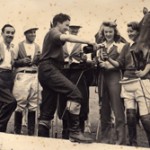
DESCRIPTIVE SUMMARY
Collection Number
2002H.1
Creator
???
Extent
Number of Containers: Three (3) Boxes
Linear Feet: 1.5 Linear Feet
Repository
Santa Cruz Museum of Art & History, Archives
705 Front Street
Santa Cruz, CA 95060
Abstract
This collection consists of photographs (1911-1980s), scrapbooks (1970s-1980s), business documents (1980s-1990s), Tennis League documents (1970s-1990s), and recognition plaques (1970s-1980s).
Location
The Santa Cruz Museum of Art & History, Santa Cruz, CA
Preferred Citation
The Pogonip Collection, The Santa Cruz Museum of Art & History, Santa Cruz, CA
Publication Rights
All requests for permission to publish or quote from manuscripts must be submitted in writing to the head of Archives at MAH. Researchers may be responsible for obtaining copyright permission to use material not produced by museum personnel.
Process By
???
Date Completed
???
Pogonip was once part of the extensive Cowell Ranch, originally purchased by Henry Cowell for its lime and timber resources. In 1912, Fred Swanton, developer of the Santa Cruz Beach Boardwalk, opened an eighteen-hole golf course and built a rustic clubhouse on the property. Competition from other courses led to its closure in the 1930s. The area was then transformed into popular polo fields. The Pogonip Polo Club was well known in the polo world of the 1930s and 1940s; the Polo Club was especially noteworthy due to Dorothy Deming Wheeler and the women’s polo team. Dorothy Wheeler ensured the polo club was not restricted to men, and Santa Cruz became one of the few areas where women’s polo was accepted. World War II brought an end to polo at Pogonip and for a short time the facilities served as a rehabilitation site for servicemen. The Pogonip Club reopened in 1948 as a private social organization and remained a social club even after the clubhouse was condemned in 1987. The property was purchased in 1989 with funding from the CALPAW State Bond Act. It is currently an open space belonging to the Santa Cruz City Parks and Recreation Department. The bulk of this collection represents the Pogonip Club era with materials collected by member Jeremy Lezin.